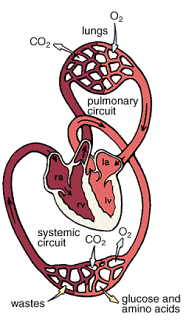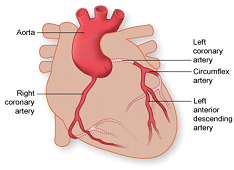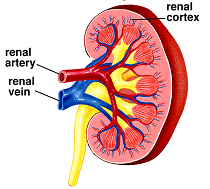In this article, we shall study types of blood circulation in human body.
Pattern of Circulation
Our Blood
moves through the body in an uninterrupted fashion in the following sequence:
1] Left ventricle
2] systemic circulation (body)
3] right atrium
4] right ventricle
5] pulmonary circulation (lungs)
6] left atrium left ventricle.

Double Circulation:
Double circulation is a process during which blood passes twice through the heart during one complete cycle. This type of circulation is found in amphibians, reptiles, birds, and mammals. However, it is more prominent in birds and mammals as in them the heart is completely divided into four chambers – the right atrium, the right ventricle, the left atrium, and the left ventricle.
The movement
of blood in an organism is divided into two parts: (i) Systemic circulation
(ii) Pulmonary circulation
Systemic circulation starts at the left ventricle and ends at the right atrium.
It carries blood to and from the rest of the body. Pulmonary circulation
involves the movement of deoxygenated blood from the right ventricle to the
pulmonary artery, which then carries blood to the lungs for oxygenation. From
the lungs, the oxygenated blood is carried by the pulmonary veins into the left
atrium. Hence, in double circulation, blood has to pass alternately through the
lungs and the tissues.
Significance of double circulation:
- The separation of oxygenated and deoxygenated blood allows a more efficient supply of oxygen to the body cells.
- Blood is circulated to the body tissues through systemic circulation and to the lungs through the pulmonary circulation.
Systemic Circulation:
It starts at the left ventricle and ends at the right atrium. It carries blood to and from the rest of the body. There are three parts of the systemic circulation
Coronary Circulation:

The heart itself receives its supply of blood from the two coronary arteries leading from the aorta. Blood enters into capillaries that lead to veins through which blood returns to the right atrium. This circulation is called coronary circulation. Thus supplying blood to the heart muscle takes place.
Renal Circulation:

In this type of circulation, blood is circulated to the kidneys (renal artery). Nearly 25% of the blood leaving the heart flows to the kidneys, which are pressure filters for waste.
Hepatic Portal Circulation:

In this type nutrients picked up by capillaries in the small intestines are transported directly to the liver in the hepatic portal vein, where excess nutrients are stored. This is about 70% of the liver’s blood supply. The liver also receives oxygenated blood from the hepatic artery, which branches off the aorta, and provides 30% of its blood. All blood leaves the liver through the hepatic vein.
Pulmonary Circulation:

Deoxygenated blood is pumped from the right ventricle into the lungs through the pulmonary arteries – the only arteries to carry deoxygenated blood. Blood returns to the heart through the pulmonary veins, the only veins to carry oxygenated blood. This is pulmonary circulation.